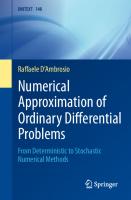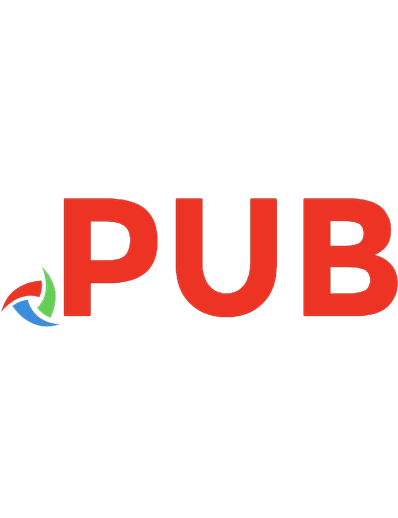Numerical Approximation of Hyperbolic Systems of Conservation Laws [2 ed.] 1071613421, 9781071613429
This monograph is devoted to the theory and approximation by finite volume methods of nonlinear hyperbolic systems of co
290 98 44MB
English Pages 853 Year 2021
Table of contents :
I Introduction
1 Definitions and Examples
2 Fluid Systems in Eulerian and Lagrangian Frames
3 Some Averaged Models: Shallow Water, Flow in a Duct, and Two-Phase Flow
4 Weak Solutions of Systems of Conservation Laws
4.1 Characteristics in the Scalar One-Dimensional Case
4.2 Weak Solutions: The Rankine-Hugoniot Condition
4.3 Example of Nonuniqueness of Weak Solutions
5 Entropy Solution
5.1 A Mathematical Notion of Entropy
5.2 The Vanishing Viscosity Method
5.3 Existence and Uniqueness of the Entropy Solution in the Scalar Case
Notes
II Nonlinear Hyperbolic Systems in One Space Dimension
1 Linear Hyperbolic Systems with Constant Coefficients
2 The Nonlinear Case, Definitions and Examples
2.1 Change of Variables, Change of Frame
2.1.1 Nonconservative Variables
2.1.2 Characteristic Fields in the Eulerian and Lagrangian Frames
2.2 The Gas Dynamics Equations
2.3 Ideal MHD
3 Simple Waves and Riemann Invariants
3.1 Rarefaction Waves
3.2 Riemann Invariants
4 Shock Waves and Contact Discontinuities
5 Characteristic Curves and Entropy Conditions
5.1 Characteristic Curves
5.2 The Lax Entropy Conditions
5.3 Other Entropy Conditions
5.3.1 Entropy-Entropy Flux
5.3.2 Liu's Entropy Condition, Viscous Profile
6 Solution of the Riemann Problem
7 Examples of Systems of Two Equations
7.1 The Case of a Linear or a Linearly DegenerateSystem
7.2 The Riemann Problem for the p-System
7.3 The Riemann Problem for the BarotropicEuler System
7.3.1 The Barotropic Euler System
7.3.2 Correspondence with the p-System
7.3.3 The Saint-Venant System
Notes
III Gas Dynamics and Reacting Flows
1 Preliminaries
1.1 Properties of the Physical Entropy
1.2 Ideal Gases
2 Entropy Satisfying Shock Conditions
3 Solution of the Riemann Problem
4 Reacting Flows: The Chapman-Jouguet Theory
5 Reacting Flows: The Z.N.D. Model for Detonations
Notes
IV Finite Volume Schemes for One-Dimensional Systems
1 Generalities on Finite Volume Methods for Systems
1.1 Extension of Scalar Schemes to Systems: Some Examples
1.2 L2 Stability
1.3 Dissipation and Dispersion
2 Godunov's Method
2.1 Godunov's Method for Systems
2.2 The Gas Dynamics Equations in a Moving Frame
2.3 Godunov's Method in Lagrangian Coordinates
2.4 Godunov's Method in Eulerian Coordinates(Direct Method)
2.5 Godunov's Method in Eulerian Coordinates (Lagrangian Step +-.4 Projection)
2.6 Godunov's Method in a Moving Grid
3 Godunov-Type Methods
3.1 Approximate Riemann Solvers and Godunov-Type Methods
3.1.1 Consistency Condition for an Approximate Riemann Solver
3.1.2 Simple Approximate Riemann Solvers
3.1.3 Application to Fluid Systems
3.2 Roe's Method and Variants
3.2.1 Roe-Type Linearization and Roe Matrix
3.2.2 The Numerical Flux of Roe's Scheme
3.2.3 Entropy Correction
3.2.4 The VFRoe Scheme
3.3 The H.L.L. Method
3.4 Osher's Scheme
3.4.1 The Scalar Case
3.4.2 Osher's Scheme for a System
3.4.3 Application to the Gas Dynamics System
4 Roe-Type Methods for the Gas Dynamics System
4.1 Roe's Method for the Gas Dynamics Equations: (I) The Ideal Gas Case
4.1.1 Computation of Roe's Matrix via Parameter Vectors
4.1.2 Determination of the Coefficients in Roe's Scheme
4.2 Roe's Method for the Gas Dynamics Equations: (II) The ``Real Gas'' Case
4.3 A Roe-Type Linearization Based on Shock Curve Decomposition
4.4 Another Roe-Type Linearization Associated with a Path
4.5 The Case of the Gas Dynamics System in Lagrangian Coordinates
4.5.1 Roe's Method in Lagrangian Coordinates
4.5.2 Toward a Positively Conservative and Entropy Satisfying Godunov-Type Scheme
4.5.3 A Simple Riemann Solver in Eulerian Coordinates
5 Flux Vector Splitting Methods
5.1 General Formulation
5.2 Application to the Gas Dynamics Equations: (I) Steger and Warming's Approach
5.3 Application to the Gas Dynamics Equations: (II) Van Leer's Approach
6 Van Leer's Second-Order Method
6.1 Van Leer's Method for Systems
6.2 Solution of the Generalized Riemann Problem
6.3 The G.R.P. for the Gas Dynamics Equations in Lagrangian Coordinates
6.4 Use of the G.R.P. in van Leer's Method
7 Kinetic Schemes for the Euler Equations
7.1 The Boltzmann Equation
7.2 The B.G.K. Model
7.3 The Kinetic Scheme
7.3.1 The Time Discretization
7.3.2 The Space Discretization
7.3.3 A Maximum Principle on the Entropy
7.3.4 Second-Order Accurate Schemes
7.4 Some Extensions of the Kinetic Approach
7.4.1 Kinetic Representation
7.4.2 Discrete Kinetic Approximations
8 Relaxation Schemes
8.1 Introduction to Relaxation
8.1.1 The General Relaxation System
8.1.2 Relaxation and Approximation
8.2 Model Examples
8.2.1 Relaxation to a Scalar Conservation Law
8.2.2 Introduction to the Jin–Xin Relaxation Scheme
8.2.3 Generalization
8.2.4 Selective Relaxation for the p-System
8.3 A Relaxation Scheme for the Euler System
8.3.1 Suliciu Relaxation for the Isentropic Euler System
8.3.2 Entropy and the Relaxation Procedure
8.3.3 The Relaxation Solver for the Isentropic Euler System
8.3.4 The Relaxation Solver for the Euler System
Notes
V The Case of Multidimensional Systems
1 Generalities on Multidimensional Hyperbolic Systems
1.1 Definitions
1.2 Characteristics
1.3 Simple Plane Waves
1.4 Shock Waves
2 The Gas Dynamics Equations in Two Space Dimensions
2.1 Entropy and Entropy Variables
2.2 Invariance of the Euler Equations
2.3 Eigenvalues
2.4 Characteristics
2.5 Plane Wave Solutions: Self-Similar Solutions
2.5.1 Simple Plane Waves and Contact Discontinuities
2.5.2 Plane Shock Waves
2.5.3 Plane Riemann Problem
2.5.4 Characteristic Equations
2.5.5 Self-Similar Solutions
3 Multidimensional Finite Difference Schemes
3.1 Direct Approach
3.1.1 Difference Schemes in Conservation Form
3.1.2 L2 Stability
3.1.3 Total Variation
3.2 Dimensional Splitting
4 Finite-Volume Methods
4.1 Definition of the Finite-Volume Method
4.1.1 General Principles
4.1.2 Properties
4.1.3 Examples
4.2 General Results
4.2.1 Order
4.2.2 The Lax–Wendroff Theorem
4.2.3 Stability
4.3 Usual Schemes
4.3.1 Roe's Scheme
4.3.2 Fully Two-Dimensional Roe's Linearization
4.3.3 Application to Gas Dynamics
4.3.4 The Osher Scheme
4.3.5 Flux-Vector Splitting
5 Second-Order Finite-Volume Schemes
5.1 MUSCL-Type Schemes
5.1.1 MUSCL-Type Cell-Centered Schemes
5.1.2 MUSCL-Type Cell Vertex Schemes
5.2 Other Approaches
6 An Introduction to All-Mach Schemes for the System of Gas Dynamics
6.1 The Low Mach Limit of the System of GasDynamics
6.2 Asymptotic Analysis of the Semi-DiscreteRoe Scheme
6.3 An All-Mach Semi-Discrete Roe Scheme
6.4 Asymptotic Analysis of the Semi-DiscreteHLL Scheme
6.5 An All-Mach Semi-Discrete HLL Scheme
Notes
VI An Introduction to Boundary Conditions
1 The Initial Boundary Value Problem in the Linear Case
1.1 Scalar Advection Equations
1.1.1 One-Dimensional Scalar Advection Equation
1.1.2 Two-Dimensional Scalar Advection Equation
1.2 One-Dimensional Linear Systems. Linearization
1.3 Multidimensional Linear Systems
1.3.1 Uniform Kreiss Condition (U.K.C.)
1.3.2 The Characteristic Manifold
1.3.3 Group Velocity and Incoming/Outgoing Modes
2 The Nonlinear Approach
2.1 Nonlinear Equations
2.2 Nonlinear Systems
3 Gas Dynamics
3.1 Fluid Boundary (Linearized Approach)
3.2 Solid or Rigid Wall Boundary
4 Absorbing Boundary Conditions
5 Numerical Treatment
5.1 Finite Difference Schemes
5.2 Finite Volume Approach
5.2.1 Solid Wall Boundary
5.2.2 Fluid Boundary
Notes
VII Source Terms
1 Introduction to Source Terms
1.1 Some General Considerations for Systems with Source Terms
1.2 Simple Examples of Source Terms in the Scalar Case
1.3 Numerical Treatment of Source Terms
1.3.1 Direct Finite Volume Treatment of the Equation
1.3.2 Splitting or Fractional Step Methods
1.4 Examples of Systems with Source Terms
2 Systems with Geometric Source Terms
2.1 Nonconservative Systems
2.1.1 Nonconservative Systems Coming from Systems with a Geometric Source Term
2.1.2 Definition of the Nonconservative Product Based on a Family of Paths
2.1.3 A Result Concerning Linearly Degenerate Characteristic Fields
2.2 Stationary Waves and Resonance
2.3 Case of a Nozzle with Discontinuous Section
2.4 The Example of the Shallow Water System
3 Specific Numerical Treatment of Source Terms
3.1 Some Numerical Considerations for Flow in a Nozzle
3.2 Preserving Equilibria, Well-Balanced Schemes
3.2.1 Upwinding the Source: A Scalar Example
3.2.2 Well-Balanced Schemes for Geometric Source Terms
3.3 Schemes for the Shallow Water System
3.3.1 Important Properties
3.3.2 Hydrostatic Reconstruction
3.3.3 Some Complements on Shallow Water Models
4 Simple Approximate Riemann Solvers
4.1 Definition of Simple Approximate Riemann Solvers
4.2 Well-Balanced Simple Schemes
4.3 Simple Approximate Riemann Solvers in Lagrangian or Eulerian Coordinates
4.4 The Example of the Gas Dynamics Equations with Gravity and Friction
4.4.1 Derivation of a Simple Approximate Riemann Solver in Lagrangian Coordinates
4.4.2 Derivation of a Simple Approximate Riemann Solver in Eulerian Coordinates
4.4.3 Equilibria of the Continuous System and Well-Balanced Property
4.5 Link with Relaxation Schemes
4.5.1 Euler System with Gravity and Friction: Homogeneous Formulation
4.5.2 Relaxation Scheme for Euler System with Gravity and Friction
5 Stiff Source Terms, Asymptotic Preserving NumericalSchemes
5.1 Introduction
5.2 Some Simple Examples
5.2.1 Stiffness, Multiscale Resolution
5.2.2 A Linear Model
5.2.3 Some Related Simple Models
5.2.4 A Nonlinear Model
5.3 Derivation of an AP Scheme for the Linear Model
5.3.1 Scheme for the System Before and After Scaling
5.3.2 AP Scheme for the Scaled System
5.4 Euler System with Gravity and Friction
5.4.1 Asymptotic Behavior for Large Friction
5.4.2 Asymptotic Preserving Property
5.4.3 An AP Modification of the Scheme
6 Interface Coupling
6.1 Introduction to Interface Coupling
6.2 The Interface Coupling Condition
6.2.1 General Interface Coupling
6.2.2 Coupled Riemann Problem (CRP)
6.2.3 Interface Coupling of Two p-Systems
6.2.4 Coupling Systems of Different Sizes
6.3 Numerical Coupling
Notes
References
Index
![Numerical Approximation of Hyperbolic Systems of Conservation Laws [2 ed.]
1071613421, 9781071613429](https://dokumen.pub/img/200x200/numerical-approximation-of-hyperbolic-systems-of-conservation-laws-2nbsped-1071613421-9781071613429.jpg)
![Numerical Approximation of Hyperbolic Systems of Conservation Laws [2 ed.]
1071613421, 9781071613429](https://dokumen.pub/img/200x200/numerical-approximation-of-hyperbolic-systems-of-conservation-laws-2nbsped-1071613421-9781071613429-f-8211559.jpg)
![Hyperbolic Systems os Conservation Laws [1 ed.]](https://dokumen.pub/img/200x200/hyperbolic-systems-os-conservation-laws-1nbsped.jpg)
![Hyperbolic conservation laws in continuum physics [4 ed.]
9783662494493, 9783662494516](https://dokumen.pub/img/200x200/hyperbolic-conservation-laws-in-continuum-physics-4nbsped-9783662494493-9783662494516.jpg)





![Handbook of Numerical Methods for Hyperbolic Problems Applied and Modern Issues [1st Edition]
9780444639110, 9780444639103](https://dokumen.pub/img/200x200/handbook-of-numerical-methods-for-hyperbolic-problems-applied-and-modern-issues-1st-edition-9780444639110-9780444639103.jpg)
![Handbook of Numerical Methods for Hyperbolic Problems Basic and Fundamental Issues [1st Edition]
9780444637956, 9780444637895](https://dokumen.pub/img/200x200/handbook-of-numerical-methods-for-hyperbolic-problems-basic-and-fundamental-issues-1st-edition-9780444637956-9780444637895.jpg)